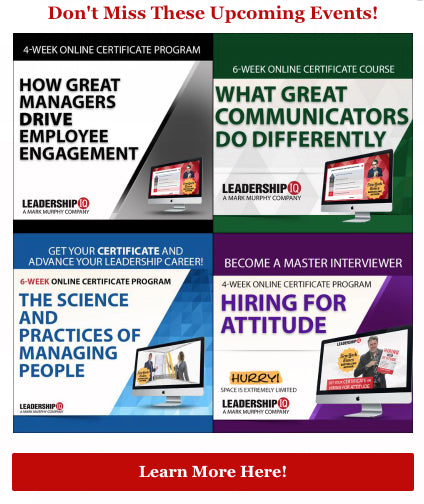The Script That New Managers Need To Use When Meeting Their New Employees
This article originally appeared on Forbes by Mark Murphy, Founder of Leadership IQ
New managers have a fair number of challenges; maybe they’re a manager for the first time, or taking over a new team that loved their previous manager, or they got promoted over some of the employees they now have to manage.
Whatever the situation, the first thing a new manager has to do, before sitting down and talking to all the people on the team, is to understand ‘what are my goals?’ and ‘what have I been put in this leadership role to accomplish?’
Ostensibly, the new manager has been given goals. There are priorities that the organization, or the boss, has for this leadership role. Maybe the manager was hired to increase productivity. Or grow revenue. Or improve accountability, or make sure that we produce more widgets per month, or have fewer defect rates.
The second thing new managers have to understand is ‘who do we serve?’ and ‘who are our customers?’ Managers often say, ‘I’m in HR, I’m in Supply Chain Management, I’m in Procurement, I don’t really have a customer, all the customers are outside the building.’ But that’s the wrong answer. We all have customers, we all serve somebody, and whether they’re internal or external customers, every one of us is in service of somebody.
We have to understand who those customers are because new leaders are going to need the customer, internal or external, as a source of power. The customer is one of the most powerful sources available. The customer is one of the greatest legitimizers, and people forget them all the time. Without customers we do not exist, so we’ve got to understand who they are and what we need to deliver for them.
Once the new manager understands those two pieces, they’re ready to sit down and introduce themselves to each member of the team individually. It’s generally a good idea to meet with each person individually, because it cuts down on all of the interpersonal dynamics that would occur with a meeting of numerous employees.
The first thing we want to offer is a statement of excitement. Basically, “I am so excited to meet you. I’m so excited to get to know you. I’m so excited to be working together.” We can frame it any number of ways as long as it starts on a very positive note that says “I am excited, this is going to be good.”
Second, we’re basically going to say, “I am here to achieve X goals,” with “X” being whatever the manager’s goals are. Remember that these are the goals that the new manager has received from the organization. And then they’re going to add “And I’m here to help us deliver extraordinary service for our customers.” The word ‘service’ can be changed to quality or whatever it is the new manager has been hired to deliver.
So our first few sentences are essentially saying:
“I’m here. I’m excited. I’m here to achieve X goals that been given to me by the organization. I’m here to achieve extraordinary service, quality, etc. for our customers.”
Starting the conversation this way, the new manager claims the legitimacy and power that comes from achieving the organization’s goals and service to the customer. Whether the employees are older than the new manager, more experienced, bitter from being passed over, or whatever, beginning the conversation by claiming legitimacy shuts down a lot of potential passive-aggressiveness.
Now, once the new manager has this power they can say “I’m really looking forward to your ideas on how we can do those two things (achieve the goals and serve the customers).” Even though the conversation starts with claiming legitimacy and power, we don’t want to wave that in employees’ faces. So the new manager should reach out a hand of friendship and collaboration. And they can further that collaboration by asking their employee “I also would like to understand ‘what are your goals?’”
When this is all put together, it sounds something like:
“I’m really excited to be working with you. This is great. I’m really excited to get to know you, and to work even more closely with you. Let me tell you a bit about kind of why I’m here. I’m here to help us achieve X number of goals (whatever those things are), and to make sure that we deliver extraordinary service, quality, etc. to our customers. I’m really looking forward to your ideas on how we can achieve those two goals. I’m also interested, while we’re talking, to hear what your goals are. Given everything I’ve just said, let me ask you, what are your goals for this next year?”
By framing the conversation this way, new managers are legitimizing themselves and reducing lots of potential resentment or passive-aggressiveness while simultaneously building collaboration and investing in their new employees.
Mark Murphy is the author of Truth At Work: The Science Of Delivering Tough Messages, Hiring For Attitude and Hundred Percenters.







